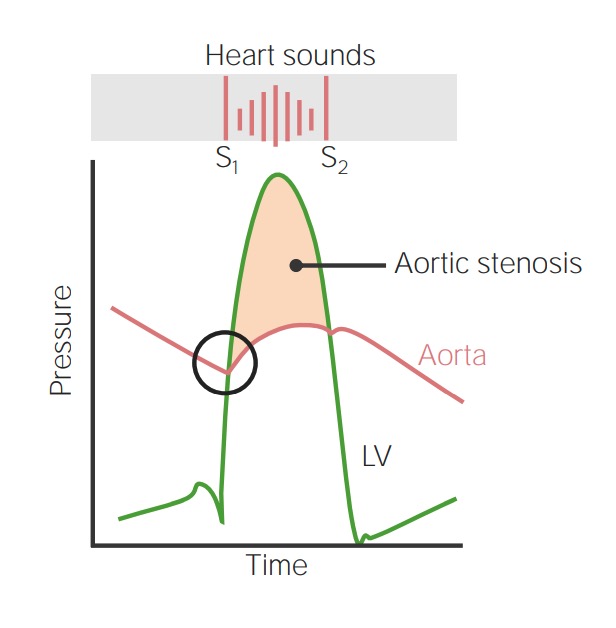Playlist
Show Playlist
Hide Playlist
Changing Concepts – Valvular Heart Disease
-
Slides Valvular Heart Diseases.pdf
-
Reference List Cardiology.pdf
-
Download Lecture Overview
00:08 Today, we're going to consider valvular heart disease. 00:11 As you all remember, there are four valves in the heart, but one valve, the aortic valve, is much more commonly involved with disease than any of the others in today's patients. 00:22 Valve disease has been recognized for a very long time. 00:25 Here, we see in a diagram taken from an 18th century English manuscript that already, at the time of autopsy, valvular heart disease was recognized. 00:35 This patient undoubtedly had syphilitic involvement of the aortic valve, something that's very rare today, but was quite common in the 1800s. 00:45 4 or 5 decades ago, there were many patients who would have acute rheumatic fever in childhood and then who develop chronic rheumatic heart disease, often with involvement of the mitral and aortic valve. 00:57 Acute rheumatic fever has almost disappeared in Western Europe and North America. 01:03 Still very common in many parts of Asia and Africa, but most of the patients that we see these days have -- that have rheumatic heart disease have come from somewhere in the developing world because acute rheumatic fever is almost eradicated in childhood in the west. 01:24 We see mostly congenital forms of valvular heart disease. 01:28 That is valves that have had myxomatous degeneration. 01:33 I'll show you examples of that, particularly the mitral valve. 01:36 We see patients who have a bicuspid aortic valve instead of the normal tricuspid valve, and then there are a number of acquired valve conditions. 01:44 Patients with coronary artery disease can damage the papillary muscles leading to abnormal function of the mitral valve, patients with hereditary hypertrophic cardiomyopathy may develop some aortic or mitral valve disease with time, and then older individuals may develop atherosclerosis on the aortic valve leading to aortic stenosis or aortic regurgitation. 02:08 And finally, any damaged valve is particularly susceptible to bacterial infection and infectious endocarditis. 02:15 The commonest valve lesion seen today is aortic stenosis and is particularly commonly seen in elderly individuals, often in their 70s or 80s, and is due to atherosclerosis. 02:28 Now, many years ago when I was a medical student and intern and a resident, the commonest lesion was mitral stenosis which was the result of acute rheumatic fever in the childhood of these individuals. 02:39 Well, as we already mentioned, rheumatic heart disease is much less common because acute rheumatic fever has essentially disappeared in North America and in Western Europe. 02:50 Consequently, what has become the number one valve lesion is atherosclerotic calcific aortic stenosis of the elderly, which is a complication of atherosclerosis similar to coronary artery disease, peripheral vascular disease, and cerebrovascular disease. 03:06 Well, let's talk a little bit about the changing population that has led to aortic stenosis. 03:12 I think most of you are well aware that the population both in Western Europe and North America is aging very rapidly. 03:20 In fact, I believe I said in an earlier lecture that in the United States, in every 24-hour period, more individuals become aged 85 than are born. 03:31 Consequently, we have a large population of very elderly patients, many of whom have atherosclerosis and the atherosclerosis can involve the aortic valve, leading to aortic stenosis. 03:43 The other thing that has changes is as I've already mentioned, the near eradication of rheumatic fever so that we're not seeing much rheumatic heart disease anymore, but we are seeing a lot of atherosclerotic aortic valve disease or the signs of aortic stenosis or regurgitation that developed on a bicuspid aortic valve. 04:05 We're going to talk about that some more in a moment. 04:08 So, the changing population has to do with age, it has to do with the eradication of rheumatic fever, and we're going to talk for a few minutes about the associated diseases as well that these patients can have. 04:25 Elderly individuals are not immune from having other diseases, so it is not uncommon that a patient with atherosclerotic aortic stenosis will also have severe coronary artery disease, making the care of that patient more complicated. 04:40 If the left ventricle has been damaged by previous myocardial infarction, there may be mitral regurgitation secondary to injury to a papillary muscle. 04:48 So, you can see that the patients we're seeing these days with valvular heart disease are usually older and very complicated.
About the Lecture
The lecture Changing Concepts – Valvular Heart Disease by Joseph Alpert, MD is from the course Cardiac Diseases.
Included Quiz Questions
What is the most common cause of aortic valve stenosis?
- Atherosclerosis
- Rheumatic heart disease
- Myxematous degeneration of the aortic valve
- Infective endocarditis
- Bicuspid aortic valve
Which of the following statements is correct?
- Patients with hypertrophic cardiomyopathy may develop mitral valve disease with time.
- Kawasaki disease is the most common cause of mitral valve stenosis.
- Coronary artery disease can damage the papillary muscle leading to abnormal function of the pulmonary valve.
- Infective endocarditis is the most common cause of mitral valve stenosis.
- The incidence of rheumatic heart disease is increasing very rapidly in developed countries.
Customer reviews
5,0 of 5 stars
| 5 Stars |
|
5 |
| 4 Stars |
|
0 |
| 3 Stars |
|
0 |
| 2 Stars |
|
0 |
| 1 Star |
|
0 |




